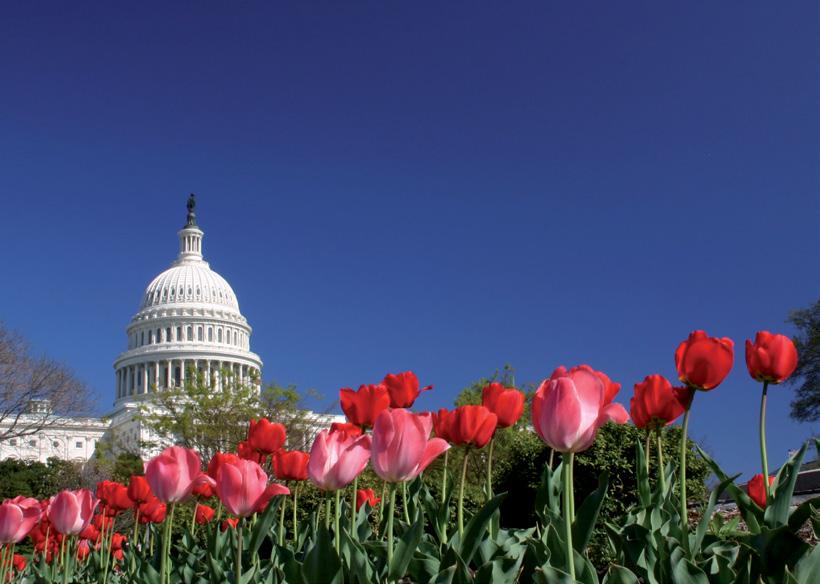
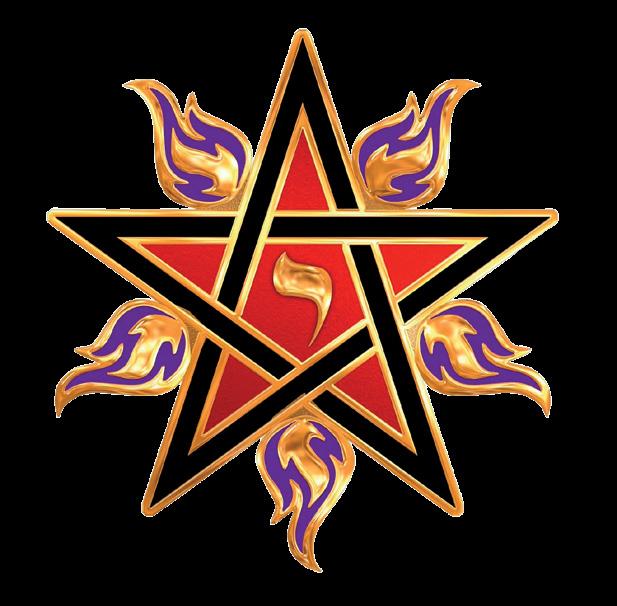
THE VOICE OF FREEMASONRY in the Nation’s Capital THE 2024 GRAND LODGE INSTALLATION MEET THE NEW GRAND SECRETARY 4TH OF JULY PARADE UNIVERSAL BROTHERHOOD CELEBRATION …AND MORE VOLUME 41, NO. 1, 2024 The Official Publication of the Grand Lodge of Free and Accepted Masons of Washington, D.C.
Editors-In-Chief: Jacob M. Bressman (Grand Master)
Adam J. Goldman, PGM (Grand Secretary)
Managing Editor: Jason Van Dyke, PM (Director of Communications)
Creative Director: Julie Palitto, Benesque Design www.benesquedesign.com dcgrandlodge.org

6

12 26
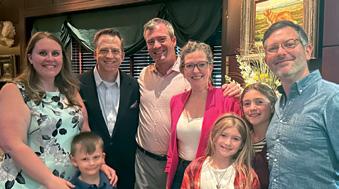
The Voice of Freemasonry is an official publication of the Grand Lodge of Free And Accepted Masons (F.A.A.M.) of the District of Columbia. Unless otherwise noted, articles appearing in this publication express only the private opinion or assertions of the writer, and do not necessarily reflect the official position of the Grand Lodge. The jurisdiction speaks only through the Grand Master, and when attested to as official, in writing, by the Grand Secretary.
The editorial staff invites contributions in the form of informative articles, reports, news and other timely information (of about 500 to 1000 words in length) that broadly relate to Masonic law, lore, customs, history, symbolism, philosophy, responsibility of membership, etiquette, current events, and/or general public interest. When possible, photographs that illustrate these informative articles should accompany the submission. Pieces submitted should be typed, double-spaced and preferably accompanied by a
computer disk in a neutral PC format or via e-mail to: grandlodge@dcgrandlodge.org
Articles are subject to editing and, when published, become the property of the Grand Lodge, F.A.A.M., of the District of Columbia. No compensation is allowed for any articles, photographs, or other materials submitted for publication.
Permission to reprint articles will be granted upon written request to the Editor from recognized Masonic publications and others. When reprinted, articles should note: “Reprinted with permission of The Voice of Freemasonry in the Nation’s Capital, (volume), (number), (year).”
Please direct all correspondence to:
Managing Editor: The Voice of Freemasonry 5428 MacArthur Blvd., N.W. Washington, D.C. 20016-2524 grandlodge@dcgrandlodge.org
M 2 3 Grand Master’s Message 4 Deputy Grand Master's Message 5 Meet the New Grand Secretary 6 Forging Bridges 10 Grand Master's Charity 11 Grand Master's Pin 12 2024 Installation 24 The Tzimtzum Paradox: Kabbalistic Origins of the Circumpunct 26 A Solemn Obligation: The Truest Length of a Masonic Cabletow 31 A Legacy in World Jazz Heritage: Afro-American Jazz and Influence of Freemasonry 35 The Positive Impact of Technology on Masonic Principles 36 The Development of Lodge Identity 41 Fourth of July Parade 42 Esoteric Conference 43 Universal Brotherhood Celebration CONTENTS THE VOICE OF FREEMASONRY VOLUME 41, NUMBER 1 2024 ISSUE
GRAND MASTER’S MESSAGE
Most Worshipful Brother
Jacob M. Bressman Grand Master
MMy Dear Brethren,

I hope that this message finds you well!
It is with great pride and gratitude that I address each of you in this message. Over the course of the year thus far, I have been incredibly impressed with the harmony and feelings of positivity which have pervaded each of our gatherings.
The dedication and hard work that each of you have put into our sacred fraternity is truly commendable. Your commitment to our shared values of brotherhood, service, and personal growth is a testament to the strength of our bond as Freemasons.
Together, we have achieved remarkable feats so far…our Schools of Instruction and Mini-Schools have been extremely well attended, our Grand Visitations have been a resounding success, our Social Hours have provided opportunities for us to get to know each other better and enjoy fellowship, and our Masonic Labors in our Lodges have been serious, and contemplative. Your efforts have not gone unnoticed, and I am honored to serve alongside such a distinguished group of Masons.

that our work is making a difference in the world around us.
Thank you, my Dear Brothers, for your support, for your friendship, brotherly love, and for all that you do – your efforts are an inspiration to us all!
As we continue on our journey, let us remain steadfast in our commitment to each other and to the principles that have guided our Craft from time in memoriam. Let us continue to uphold the tenets of Freemasonry with integrity, knowing
Sincerely
& Fraternally, Jacob M. Bressman Grand Master
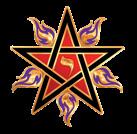
VOL. 40, NO. 1, 2023 3
DEPUTY GRAND MASTER’S MESSAGE
WE ARE THE MASONS OF WASHINGTON, D.C.WE ARE THE MASONS OF THE NATION’S CAPITAL!
by Eric Kuchner | Deputy Grand Master
IIn order to steer the ship of the present into the future we must never forget “from whence we came”—our history, our traditions, our rituals, our values, and our landmarks. All of these things together create an intellectual, emotional, and physical foundation and scaffolding for our living temple. And as we travel down this winding road together, at times be-fit with ruffians who demand our personal bravery and courage to stay true to our Masonic values it also challenges us to grow personally as leaders… we must be willing to make ourselves vulnerable and keep our living temple sacrosanct as we explore the intellectual and emotional challenges of a post-modern world - and work together to practice Freemasonry to repair these tears.


Spring is an ancient symbolic moment for both remembrance and for renewal – a time to take a pause from our daily distractions and the hustle and bustle of life—to put down our phones and to reflect on our lives – to draw plans upon our own trestle boards for the coming season, and to inhale the breath of renewed hope and prosperity that Spring brings with it, each year. As we reflect back upon the inspiration of our Masonic values we must challenge ourselves through duty, service, modesty, and humility before G-D and our fellow mankind, and remind ourselves that we are a beacon of hope, civility, and prosperity - elevating humanity to its finest.
Often I have found myself having to answer the question: “So who are the Freemasons?” and “What do you do?” and I am certain that many of you have faced similar questions or have asked those exact questions yourselves. As Brethren, we are connected by history, traditions, rituals, obligations, and shared values about our communities, humanity, and the world around us. We are a nucleus—our universal truths - ancient in origin - have been passed from one generation to the next hidden in ancient symbols, rituals, and allegories. Let us not forget that at the heart of it we are Master Masons and carry those expectations throughout our lives—black tie galas and fellowship events are all wonderful sources of life energy and a chance to gather together to enjoy the sweetness of the nectar that is created by Freemasonry when it is practiced with accuracy and enthusiasm—but being a mason is a way of life 24/7, 365! Freemasonry is a code of conduct—a set of expectations— an outlook on life.
Washington, D.C. is a special place to live, to work, to raise a family, and to be a Freemason. We live in one of the greatest cosmopolitan cultural centers in the world, surrounded by the symbols of liberty and freedom, self-governance and hope, knowledge and wisdom, truth and justice, duty, service, and sacrifice.
The Nation’s capital is a cross roads—a place where everyone from around the world comes together to bathe in our glorious experiment in self - governance that drives innovation, commerce, liberty, and the rule of law. It is on Masonic bedrock that our Nation’s Capital and for that matter our American Experiment resides. We are the Freemasons of Washington, D.C. and the heartbeat of Freemasonry Universal – we have a special responsibility to the Craft to be role models of civic virtue, of modesty and humility, and serve as champions for Masonic and American values. We have so much to be proud of!
THE VOICE OF FREEMASONRY 4
MEET OUR NEW GRAND SECRETARY!
RRight Worshipful Brother Adam J. Goldman is the Grand Lodge of the District of Columbia’s first new Grand Secretary in nearly a decade – and he brings to the Grand Lodge Office a wealth of experience, being of Service to others.
Professionally, RWB Goldman started his life as a Public Servant more than 30 years ago by enlisting in the U.S. Army as an Infantryman during Operation Desert Storm. After that, he never strayed too far from the Veteran Community and has worked on programs, such as National Stand Down, which helps homeless Veterans with all aspects of regaining control over their lives. He has also worked with the VA Medical Center and Veterans Village of San Diego but, for the last 10 years, RWB Goldman has focused on other underserved populations, by working as a Social Scientist and Policy Analyst on America’s Medicaid Program.
Consistent with his love for Veterans, our new Grand Secretary was Initiated, Passed and Raised in his hometown, San Diego’s North County, at a predominantly Marine Corps Lodge, due East of Oceanside’s Camp Pendleton, Vista No. 687. During that time, he also began focusing on higher education and, with the support of his Brethren, was accepted into a Graduate Program studying Political Demography at the University of London – so he travelled West to East, in Search of More Light.
studied in Europe, is that he was able to hone his skills in French and Spanish – which are two of the foreign languages spoken in D.C. Lodges.
From his foundational SRIA teachings, RWB Goldman began focusing, in earnest, on the areas of Qabalah, Gematria & Numerology, Traditional Astrology, Tarot, Alchemy, Rosicrucianism and corresponding Philosophies. He also began sharing his research through numerous Masonic lectures – which is how many of us came to know him, after he came to D.C., originally, as a Graduate Intern at the Stimson Center.
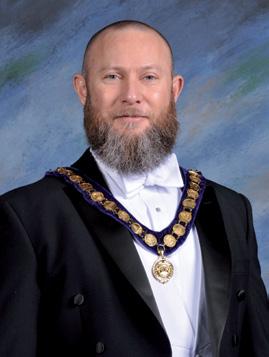
While studying in the UK, RWB Goldman became an Officer in Portsoken Lodge No. 5088 – the very Lodge where his Great-Grandfather, as Worshipful Master in 1943, Raised his own Grandfather, while a young Captain in the Royal Army during WWII. It was also during his time in England that RWB Goldman was introduced to many of the more “esoteric” concepts in Masonry, through the Societas Rosicrucian in Anglia (SRIA) and similar groups focusing on the Western Esoteric Tradition. Another benefit of having
After returning to the Nation’s Capital permanently in 2013, RWB Goldman immediately became very active in D.C. Masonry and, eventually, served as Worshipful Master of Harmony Lodge No. 17 in 2016.
From his experience as Master, he discovered that his beloved Masonic Education could only take root when combined with effective Lodge Planning and Administration. To continue supporting his Lodge, RWB Goldman became Secretary of Harmony in 2017 and, later, Assistant Secretary of Freedom Military Lodge No. 1775.
In addition to his duties as Grand Secretary, RWB Goldman currently serves as Celebrant of the Masonic Rosicrucians of Washington, D.C. and Vice President of D.C.’s National Sojourners for Masonic Veterans. He is particularly active in the Scottish Rite and is a Past Venerable Master of the Mithras Lodge of Perfection and Knight Commander of the Court of Honor. That said, RWB Goldman is most excited about being this year’s Senior Warden of Lodge Adhuc Stat, U.D. – the first Lodge in America to work the Craft Degrees of the Rectified Scottish Rite.
VOL. 40, NO. 1, 2023 5
Continued on page 114
Our new Grand Secretary RWB Adam J. Goldman
FORGING BRIDGES
Wby Eric Kuchner | Deputy Grand Master
All pictures courtesy of Most
Worshipful Prince Hall Grand
What a night it had been! We were welcomed with open arms of Brotherly love, and the warmth family—the banquet hall was filled with the delicious aromas of new cuisine and a celebratory glow. It has been almost two decades since the first time I walked through the doors of U Street into a Prince Hall Lodge meeting and was greeted with the same open arms. But tonight was different – tonight we were honored guests celebrating the new Prince Hall Grand Master and the bridges of fraternal relations forged by our Grand Master, Most Worshipful Brother Jacob M. Bressman.
Seeing these two leaders side by side at the head table was a symbolic moment. A culmination of decades of work done by long gone members of our Craft to build fraternal warmth between our two jurisdictions one Brother, one meeting, one moment at a time.
We are increasingly facing a world where entropy and discord are tearing at the corners of civil society –it is a time in history when our communities need Freemasonry more than ever. When practiced with accuracy and enthusiasm, the Craft becomes not only a builder of civil society but stands watch as guardians of this precious fabric that is essential for stitching together our families, communities, and country into a thriving beehive of productivity and civility. It is a time for Freemasonry to bring together all corners of our Craft to stand shoulder to shoulder against the entropy that threatens to tear our
Lodge of D.C.
communities apart.

As our Universal Brotherhood Celebration quickly approaches in June – it is a time to kindle new bonds of fellowship, to extend the hand of brotherly love, relief, and truth, and to fulfill the promise of the Civil Rights Act of 1964 to elevate our amazing American Experiment in self - governance by the people and for the people– with equal justice under the law – challenging ourselves as Masons to be the role models of hope for humanity when we push ourselves to be our finest.
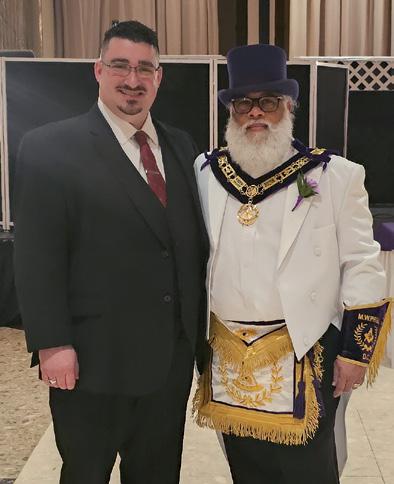
Under the leadership of our Grand Master, MWB Jacob M. Bressman, our Grand Lodge has been focusing intently on reinvigorating and renewing our bonds of brotherly love with our counterparts in the Most Worshipful Prince Hall Grand Lodge of the District of Columbia. The tenets of Freemasonry Universal and the diversity of our Craft is a point of pride for our Grand Lodge, and as such, our Grand Lodge has had the honor of participating in multiple events with the Most Worshipful Prince Hall Grand Lodge of the District of Columbia in 2024.
As his first official visit, held on Wednesday, December 13, 2023, our Grand Master, accompanied by the Deputy Grand Master, Senior Grand Warden, Junior Grand Warden, Grand Secretary, Senior Grand Deacon, Junior
THE VOICE OF FREEMASONRY 6
The Grand Master, MWB Jacob M. Bressman, with MWB Glenn Ruffin, the Grand Master of the Most Worshipful Prince Hall Grand Lodge of the District of Columbia at MWB Ruffin’s Inaugural Dinner
Grand Deacon, and Senior Grand Steward, represented our Grand Lodge at the 174th Annual Communication of the Most Worshipful Prince Hall Grand Lodge of the District of Columbia. On this occasion, our Grand Master, and as a token of the close friendship between Most Worshipful Brother Ruffin and himself, received the great honor of being made an Honorary Prince Hall Mason.

On Saturday, January 6, 2024, the Grand Master and the First Lady, accompanied by the Deputy Grand Master & his lady, the Senior Grand Warden & his lady, the Junior Grand Warden & his lady, the Grand Secretary, the Senior Grand Deacon, and Most Worshipful Brother Len Proden, PGM & his lady, attended the Inaugural Dinner and Public Installation Ceremony of Most Worshipful Brother Glenn Ruffin, the Grand Master of the Most Worshipful Prince Hall Grand Lodge of the District of Columbia.
On Monday, January 15, 2024, the Grand Master of the Grand Lodge of the District of Columbia, F.A.A.M., accompanied by Elected and Appointed Officers of this Grand Lodge, and alongside several Brethren of our
Grand Jurisdiction, had the honor of marching in Ward 8’s 43rd Martin Luther King, Jr., Day Parade. For the first time in the history of our Grand Lodge, the two D.C. Grand Masters marched side by side in the snow to commemorate and honor the legacy of Dr. Martin Luther King, Jr.
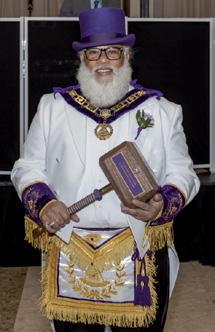
The D.C. Martin Luther King, Jr. Holiday Parade was conceived in 1977 by the late Dr. Calvin W. Rolark, founder of The Washington Informer and co-founder of the United Black Fund, along with his wife, the late Ward 8 Council member Wilhelmina J. Rolark, Esq., and the late Ralph "Petey" Greene, a community activist and radio personality. Thanks to these 3 renowned civic leaders, the District of Columbia was one of the first jurisdictions in the nation to hold a parade honoring Dr. King following his untimely death on April 4, 1968. The parade began in 1979, 6 years before King's birthday became a federal holiday. It helped in the effort to establish a national holiday in Dr. King's honor, and today it reinforces the work being done by government agencies, community non-profit organizations, and private citizens to promote Peace and non-violence locally and around the world. Across the nation and the world, Dr. King's life and legacy are commemorated by a day of service and promoted as “A Day On and Not a Day Off”.
The Martin Luther King Jr. Parade symbolizes the need to continue Dr. King's work. It reinforces the idea reflected in his words, "Human progress is neither automatic nor inevitable… every step toward the goal of justice requires sacrifice, suffering, and struggle; the tireless exertions and passionate concern of dedicated individuals." Those who believe in Dr. King's message are considered members of the Coalition for Peace and are invited to join the Martin Luther King Jr. Memorial Parade annually.
Continued on next page4
VOL. 40, NO. 1, 2023 7


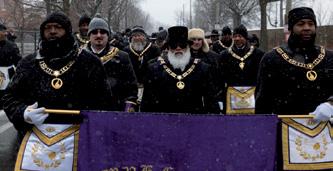

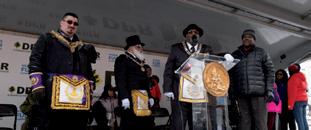



THE VOICE OF FREEMASONRY 8

On Saturday, February 24, the Grand Master attended the Most Worshipful Prince Hall Grand Lodge of the District of Columbia’s Black History Month Program at the invitation of their Grand Master. The event included a ceremony of commemoration at the African


American Civil War Memorial, along with a symposium highlighting the history of Washington, D.C.’s Prince Hall Lodges. Following these events, an excellent program was held highlighting the importance of Black History.


Following these events, our Grand Master has continued to hold regular meetings with his counterpart and has encouraged the Brethren of our Grand Lodge to continue to build strong ties of friendship and Brotherly Love with our Brothers in Prince Hall here in our Nation’s Capital. ***
We hope that you have enjoyed learning about the efforts the D.C. Masons have been making towards furthering the precepts of Freemasonry Universal, and while all

of this leading up to this year’s Universal Brotherhood Celebration, we hope that it will continue for many more years to come!
This year’s UBC will be a series of joint celebrations cohosted by our Grand Lodge, the Most Worshipful Prince Hall Grand Lodge of the District of Columbia, the D.C. Scottish Rite, and the D.C. Scottish Rite, Prince Hall Affiliated, commemorating the 60th Anniversary of the 1964 Civil Rights Act.
VOL. 40, NO. 1, 2023 9
THE GRAND MASTER’S CHARITY
by Jacob M. Bressman | Grand Master
I
I have selected the St John of Jerusalem Eye Hospital Group (SJEHG) as my charity for this year.
The St John of Jerusalem Eye Hospital Group is and has always been apolitical, and its work furthers the cause of peace in the Middle East. In a land where ethnic and religious divisions still fester and the situation changes daily, The St John of Jerusalem Eye Hospital Group has made real the ideal of peoples united by their faiths. Inspired by Christian ideals, the hospital treats mostly Muslim patients with the help of many Jewish physicians who assist in training.
St John of Jerusalem Eye Hospital Group is the only charitable provider of expert eye care in the West Bank, Gaza and East Jerusalem, treating patients regardless of ethnicity, religion or ability to pay.
The main hospital in East Jerusalem has been operating for 140 years. The Hospital is the primary provider of eye care for Palestinians in East Jerusalem, and sees many of the most complex eye cases from across the Palestinian Territories, which are referred to the Hospital from medical centers across the West Bank and Gaza. As it is the only charitable provider of eye care, the importance of the Hospital for the region cannot be overstated.
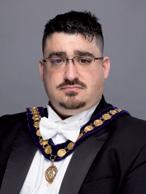
St John Eye Hospital has a large outpatients department, specialist eye units, operating theaters and 24-hour eye emergency services. There are also hospitals in Gaza and Hebron, clinics in Anabta and Kufor Aqab and mobile outreach vans.
With the renewed conflicts in the Holy Land, it is my sincere belief that supporting the St John of Jerusalem Eye Hospital Group is a worthy endeavor and is emblematic of our Masonic ideals and our hope for peace. (You can learn even more about them here: https://www.stjohneyehospital.org/)

Lodges and the Brethren are requested to contribute to this charity by making their specified donations through the D.C. Masonic Foundation in order for the Grand Lodge to make a lump-sum donation at the end of the year. Donations will be tracked and tax receipts will be provided for eligible gifts as required by the IRS. Please use the link above to donate.

I thank you all in advance for your generosity in supporting this worthy cause!

A
THE VOICE OF FREEMASONRY 10
Learn More DONATE
THE GRAND MASTER’S PIN
by Adam Goldman | Grand Secretary
AAs someone that lectures on Masonic symbolism, I have been asked several times this year to explain some of the hidden meanings behind the Grand Master’s Pin. While there may be literally thousands of interpretations, I’m happy to share a few ideas that the thoughtful reader may want to consider from the perspective of Astronomy and Traditional Astrology—and the Fellowcraft Degree.
First, the Grand Master’s Pin is, most obviously, in the shape of a Pentagram, consisting of 5 points of 36 degrees each, totaling 108 degrees in all. Astronomically, our Sun (that rules the day) is 108 times the diameter of the Earth—and the distance between Sun and Earth is 108 times the Sun’s diameter. Likewise, the average distance between the Earth and Moon (who rules the night) is 108 times the Moon’s diam eter. Further, there are 12 Astrological Signs of the Zodiac which, when multi plied by our 9 Planets, gives that same mysterious number 108. It is for these reasons, and many more, that Bud dhist prayer beads, called Malas, contain 108 beads in their chains.
Like the great messenger Mercury (Hermes) that appears in our ritual as the Junior and Senior Decans, who carry messages between the Master and Wardens, Venus orbits between our Earth and the Sun. Venus’ year is approximately 225 days and, when observed from Earth over roughly 8 of our own years, Venus comes closest to the Earth five separate times which forms a Pentagram in the Heavens. It is for this reason that the Ancients associated Venus with the Pentagram and called it, “the Petals (or Pentagram) of Venus.” Mayans were particularly observant of these Venusian cycles and the Aristotelians used Pentagrams as one their
main symbols.

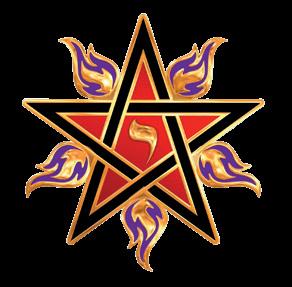
The colors of the Grand Master’s Pin also conceal Planetary influences. First, we notice the Gold color in the Pin which has long been associated with the Sun and, appropriately, the Hebrew word for Light, Aur, is the same as the French word for Gold, Or. Astrologically, the symbol for the Sun is the same as our Point-Within-a-Circle which, just happens to be, the same symbol in Alchemy used for Gold. The Red in the Pin is associated with the Planet Mars who takes its name from the Roman God of War-which is why we say when someone becomes angry, they “saw red.” “Green with envy,” likewise, comes from the Planet and Goddess of Love and Beauty, Venus, who’s metal is Copper which oxidizes Green. It is from Venus Columbe, or Venus the Dove, that we inherited our name, the District of Columb-ia.
Finally we notice the Black of the Grand Master’s Pin which relates to the Planet Saturn who’s metal is lead. Saturn is the furthest Planet from the Sun and receives the least amount of its light so Black is quite fitting for Saturn—as is lead which shields light, such as X-Rays. We also find Saturn making an appearance in our ritual as Father Time who unfurls the ringlets of the Weeping Virgin’s hair—the Virgin is the Astrological Sign, Virgo. Taken together, we might consider the Grand Master’s Pin as one symbol, or hieroglyph, camouflaging many of the Astrological and Astronomical facets that we are extolled to study, as Fellowcraft Masons, in the Quadrivium.
MEET OUR NEW GRAND SECRETARY
Like our Grand Master, RWB Goldman is also quite active in various extracurricular Civic Organizations, such as being a Freeman of the City of London, and Liveryman, in one of “the City’s” oldest Companies, the Basketmakers. When he takes a Recess from His Labors, you can find RWB Goldman at his house in the Blue Ridge Mountains, hiking
Continued from Page 5
the Appalachian Trail with his dog Blaise.
We hope that you will stop by the Grand Lodge to say hello to our new Grand Secretary, and hear about all the initiatives to help support our Grand Lodge as the Epicenter of American Freemasonry!
VOL. 40, NO. 1, 2023 11
THE 2024 INSTALLATION OF OUR NEW GRAND MASTER: A CELEBRATION OF TRADITION, UNITY, AND LEADERSHIP
by Eric Kuchner | Deputy Grand Master
OOn December 9, 2023, the Grand Lodge of Free and Accepted Masons of Washington, D.C. installed Most Worshipful Brother Jacob M. Bressman as its 213th Grand Master.
ABOUT THE GRAND MASTER
Most Worshipful Brother Jacob M. Bressman, the District of Columbia’s Grand Master for 2024, was Initiated, Passed and Raised in Washington, D.C.'s oldest Lodge, Potomac No. 5. He is a Past Master of La France Lodge No. 93 and member of other D.C. Lodges, including the Lodge of the Nine Muses No. 1776 and L’Haïtienne Lodge No. 925—the latter, for which, he was a Charter Member. He is also an Honorary Member of Mehr Lodge No. 90 and a Charter Member of Lodge Adhuc Stat, U.D.
In the York Rite, Most Worshipful Brother Bressman is a Past High Priest of Washington-Potomac Chapter No. 8 (Royal Arch Masons). In addition, he is a Past Illustrious Master of Washington Council No. 1 (Cryptic Masons), a Past Eminent Commander of Potomac Commandery No. 3 (Knights Templar), and a Past Sovereign Master of Chesapeake Bay Council No. 278 of the Allied Masonic Degrees.
For the Scottish Rite, Most Worshipful Brother Bressman has also been extremely active over the years and was invested a 32° KCCH in 2019. In addition, he has served as an Officer for the Mithras Lodge of Perfection, the Andre Salmon College of Philosophy, Knights of Saint Andrew and has also participated in several casts for Scottish Rite Reunions including, most recently, Venerable Master of Kadosh for the 32nd Degree.


THE VOICE OF FREEMASONRY 12
MWB Jacob M. Bressman receives the Gavel of Authority.
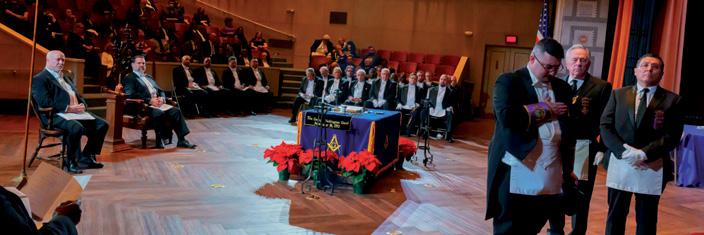
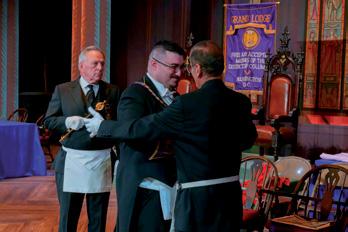

In addition to the Major Rites, Most Worshipful Brother Bressman is also a member of numerous invitational Masonic Bodies, including the Societas Rosicruciana in Civitatibus Foederatis (SRICF), Knights York Cross of Honor, Royal Order of Scotland, Knight Masons, York Rite College, Red Branch of Eri, Ancient and Masonic Order of the Scarlet Cord, Grand College of Rites, Masonic Order of Athelstan, and the Operatives.
Most Worshipful Brother Bressman has been recognized multiple times in the past for his accomplishments within the Craft, and has received several awards from various Masonic bodies, including, but not limited to, the Knight Templar Cross of Honor, the Commander of the Year Award (Knights Templar), the Masonic Education Award from the late Pythagoras Lodge of Research, the Grand Master’s Meritorious Service Award, the Grand Master’s Cornerstone Award from the Masters and Wardens Association, and the Valentine Reintzel Award. Most Worshipful Brother Bressman is deeply passionate about Masonic Education, and has published several articles on Freemasonry in multiple publications.
He has also lectured extensively within our Grand Jurisdiction and has delivered over 35 lectures within the past 4 years alone.
Most Worshipful Brother Bressman also embodies these same leadership traits and devotion to service outside of Freemasonry. He is both a Freeman of the City of London and Liveryman in the Worshipful Company of Carmen, one of the City of London’s ancient Livery Companies that focuses on the logistics and motor vehicle industry, in addition to championing various philanthropic efforts. He also serves as an Executive Officer of the Court as the Honorary Treasurer for the Honourable Company of Freemen of the City of London of North America, and is a member of the City’s Broad Street Ward Club. For his dedication to volunteer service within the Hungarian community of Greater Washington, D.C., Most Worshipful Brother Bressman has been Knighted by the Royal Prince of Hungary, and was appointed as a Member to the Most Venerable Order of the Hospital of St John of Jerusalem by His Majesty King Charles III in recognition of his charitable
Continued on next page4
VOL. 40, NO. 1, 2023 13
MWB Jacob M. Bressman is invested with the jewel of his office.
The 2024 Grand Master assents to the Ancient Charges.
The First Lady, Mrs. Yi Hu Bressman, invests the 2024 Grand Master with his top hat.
efforts. He was also awarded the Militantis Ecclesiae Medal of Benemerance in Silver for his charity by the Sacred Military Constantinian Order of Saint George.
Most Worshipful Brother Bressman is also an ordained clergyman, and was recently recognized for his community service work by being Commissioned a Kentucky Colonel. He studied at Peking University in Beijing, China,
and graduated from the George Washington University’s Elliott School of International Affairs. He speaks several foreign languages, including Mandarin Chinese, Hungarian, and Hebrew, and has also studied Arabic, French, and Japanese. Most Worshipful Brother Bressman is a career Civil Servant and lives in Gaithersburg, Maryland, with his wife, Mrs. Yi Hu Bressman, and their dog Baobao.
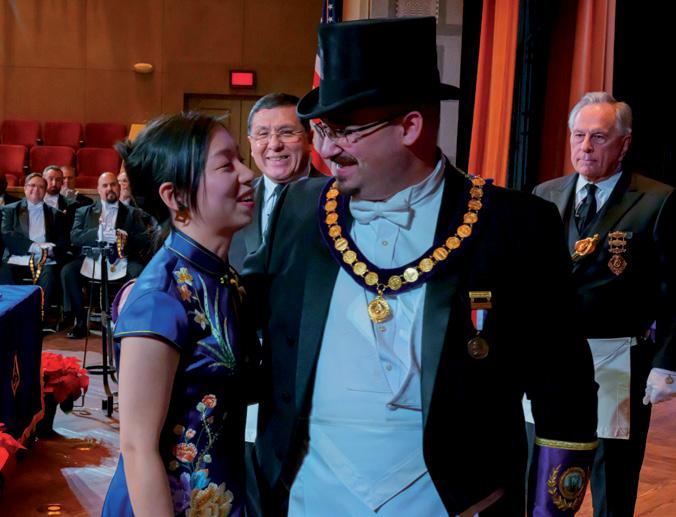

THE VOICE OF FREEMASONRY 14
The Grand Master and the First Lady
The Installation of the Grand Master is proclaimed by MWB Len Proden, PGM
THE GRAND MASTER’S INSTALLATION ADDRESS
Dearest Guests, Distinguished Visitors, Friends, Family, and Brethren All:
Good Evening!
I would like to take a moment to thank each of you for being here to celebrate the Grand Lodge of Free and Accepted Masons of the District of Columbia's 213th Installation Communication. I am extremely grateful for your support, and am very happy to have you here with us as we embark upon a new year in D.C. Masonry.
Over the past 200 years, our Grand Lodge has distinguished itself in championing the precepts of diversity, not only in terms of our Masonic Rituals and Practices, but also in terms of our membership. The diversity of our Grand Lodge is extremely unique among both American and International Grand Lodges. We are an outlier, and for this we must always be immensely proud. No matter where we come from, what language we speak, our religion, how we look, or what we believe, we are all brothers, and we are all equal. This is what makes me so very proud to be a Mason of our Nation’s Capital.
wisdom, so that we may better ourselves, coupled with spreading that wisdom to others so that it is everlasting. To me, this is what Freemasonry is: The pursuit of wisdom, to know ourselves, so that we may become better, and so that in turn, we may spread that wisdom to the world, that it may become a better place.
I have said it before, but I believe Freemasonry to be sacred. Not in the religious sense, but rather in that at its essence, it is pure, and unwavering, in that its teachings are universal, and must be applied and actualized within our daily lives. We practice Freemasonry, so that we may become better, and so that we may repair the world around us. To live, and breathe, Masonry, to practice it, and to devote ourselves to its lofty precepts will elevate our souls, and better enable us to connect with the Divine, with our God, with the Great Architect of the Universe.

My friends and family have often times asked me what Freemasonry is, and why it is so important to me. I could of course answer with the oft touted slogan that Masonry is a “Beautiful and profound system of morality, veiled in allegories and illustrated by symbols." But I feel that while this statement is true, that it does not give us the full picture. Let me instead harken back to one of the Ancient Greek Philosophers who can perhaps better explain what Freemasonry is, at least to me.
In Aristotle’s Nicomachean Ethics, Books 1 & 10, he discusses what Happiness is, and arrives at a conclusion that Happiness is not so much a state of being (for then it would be transient), but rather an activity (which is self-perpetuating and continuous). The activity which is happiness, according to Aristotle, is the pursuit of
My hopes for the coming year are simple: that we may work together in harmony, that we may leave our beloved Craft in a better state than we found it, and that we may, simply put, be happy. But we cannot do this alone.
We have all traveled a rough and rugged road to be here, to be who we are today, and it is thanks to the support of those we love and care for, that we have made it here. I have been blessed with the support, mentorship, friendship, and love of many who have helped make it possible for me to be here this evening. To each of you, I am eternally grateful, and in your honor, I will endeavor to lead our Grand Lodge with grace, decorum, and honor. Most especially, I would like to express my thanks to my loving wife, Yi – without your patience, tolerance, and support, I could not do this, and I am forever grateful to you. As a humble token of my thanks, I would like to give you this small presentation.
Thank you all once again for your support, your friendship, and for being here tonight for our Grand Lodge!
VOL. 40, NO. 1, 2023 15
Continued on next page4
Our 2024 Grand Master Most Worshipful Brother, Jacob M. Bressman




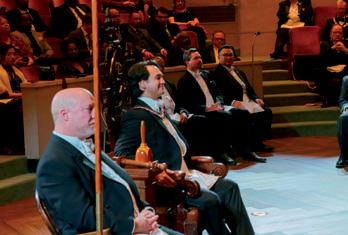
THE VOICE OF FREEMASONRY 16
RWB Eric B. Kuchner is invested with the jewel of his office
The Grand Master greets the Deputy Grand Master
RWB Chetin Durak is invested with the jewel of his office
The Senior Grand Warden assumes his station in the West
The Senior Grand Warden is presented for installation



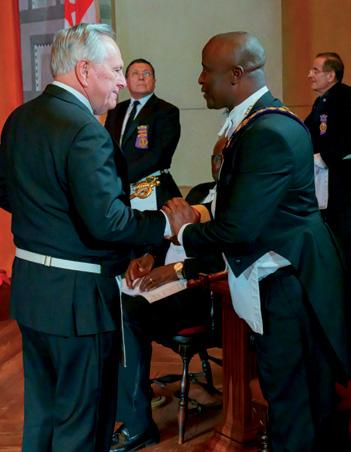
Continued on next page4
VOL. 40, NO. 1, 2023 17
The Junior Grand Warden assumes his station in the South
The Grand Secretary is presented for installation
The Grand Secretary assumes his station.
RWB Adam J. Goldman is invested with the jewel of his office
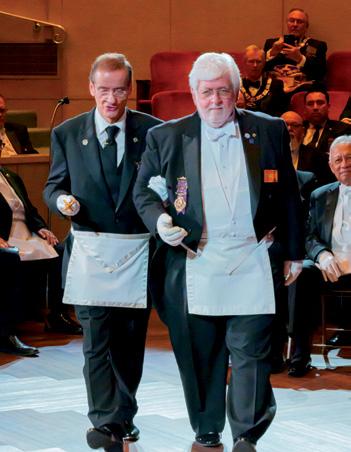



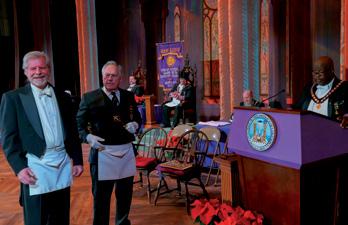

THE VOICE OF FREEMASONRY 18
MWB Alan L. Gordon, PGM is invested with the jewel of his office
The Grand Lecturer is presented for installation
The Grand Treasurer is presented for installation
The Grand Chaplian, Rev. & WB Daniel P. Dolan is presented for installation
The Deputy and Assistant Grand Chaplains are presented for installation
RWB Christopher K. Mahaney is invested with the jewel of his office

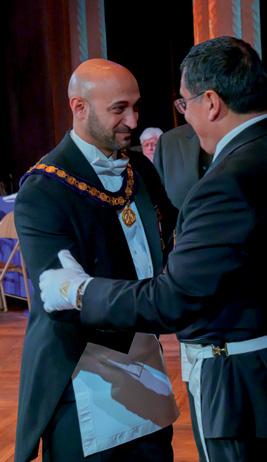


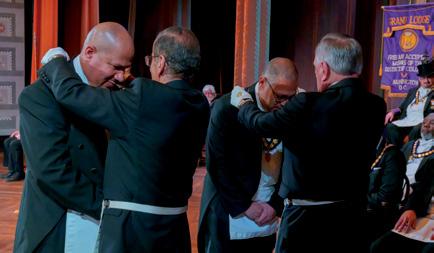
Continued on next page4
VOL. 40, NO. 1, 2023 19
The Grand Marshal, WB Amid Kasamani, is presented for installation.
The Grand Marshal is invested with the jewel of his office.
The Senior Grand Deacon, RWB Michael K. Greenwald, and the Junior Grand Deacon, RWB George S. Nicol, are presented for installation.
The Grand Deacons are invested with the jewels of their offices.
The Grand Stewards are invested with the jewels of their offices.
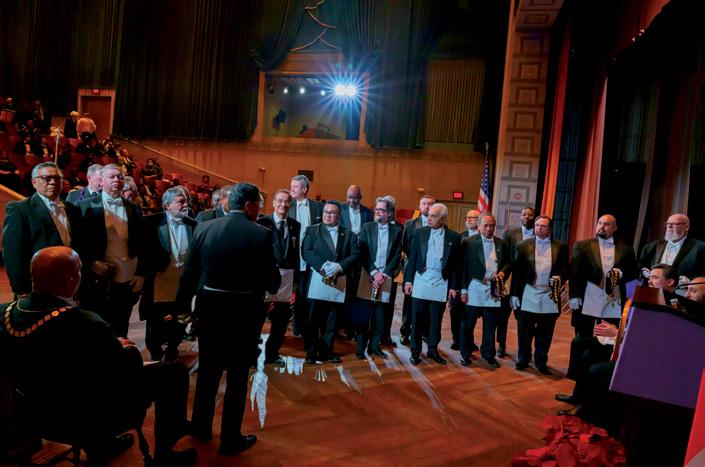

THE VOICE OF FREEMASONRY 20
The 2024 Appointed Grand Lodge Officers are presented for installation.
The Grand Master presents the First Lady with flowers.

Continued on next page4
VOL. 40, NO. 1, 2023 21
MWB Daniel A. Huertas, PGM, receives the Distinguished Service Award.

THE VOICE OF FREEMASONRY 22
MWB Jacob M. Bressman is presented with his Grand Master’s Apron.
2024 GRAND LODGE OFFICERS
Elected Officers
Grand Master ................. MWB Jacob M. Bressman
Deputy Grand Master ............ RWB Eric B. Kuchner
Senior Grand Warden .............. RWB Chetin Durak
Junior Grand Warden .......... RWB Jean-Paul Dongmo
Grand Secretary ................ RWB Adam J. Goldman
Grand Treasurer .......... MWB Alan L. Gordon, PGM
Appointed Officers
Grand Marshal ..... Amid Kasamani
Grand Sword Bearer . Karl V. Hopkins
Grand Chaplain .... Daniel P. Dolan
Grand Pursuivant ... Carl W. Hoecker
Grand Tiler .......Hector M. Ramirez
Deputy Grand Chaplain............ Andre Vainqueur
Assistant Grand Chaplain .......... Carpenter Y. Arpa IV
Assistant Grand Chaplain ................ Burton S. Levy
Assistant Grand Chaplain ............. David G. Maylum
Assistant Grand Tiler ..................Mario H. Angulo
Assistant Grand Tiler ................ Ricardo G. Estrada
Assistant Grand Tiler ................ Wuilder E. Aguero
Assistant Grand Secretary ........ Sylvanus J. A. Newstead
Assistant Grand Treasurer ................ Bassem Kaissi
Grand Historian & Deputy Grand Lecturer .............Andrew U. Hammer
Grand Lodge Physician ........ Jean A. Marcelin, Jr., M.D.
Assistant Grand Lodge Physician ........ John J. Pardalis
Grand Director of Ceremonies ......... Robb C. Mitchell
Grand Orator ...................... Joseph H. Martinez
Grand Preceptor .......................Elkanah E. Faux
Grand Almoner ..................... Ronald J. Leibfreid
Grand Lecturer .......... RWB Christopher K. Mahaney
Senior Grand Deacon ....... RWB Michael K. Greenwald
Junior Grand Deacon ............. RWB George S. Nicol
Senior Grand Steward ......... RWB Michael O. Spencer
Junior Grand Steward ............. RWB George E. Perez
Grand Organist ...... Pierrindo R. M. Palmer
Grand Provost ........ Shawn E. Eyer
Grand Photographer ..... Jacob Foko
Assistant Grand Marshal ............. Michael C. Graver
Deputy Grand Lecturer ......... Antoine N. Assi
Deputy Grand Lecturer ............ Charbel Fahed, PGM
Assistant Grand Lecturer ................... Elias Hindy
Grand Standard Bearer .......... Dominador S. Carreon
Grand Representative to CMI. . . Richard J. Bautista, PGM
Special Advisor to the Grand Master ..... Jeremy S. Barnes
Special Assistant to the Grand Master ... Patrick N. Nnaji
Aide to the Grand Master ............. Antoine Tabarani
Aide to the Grand Master ...............Costa S. Saouda
Aide to the Grand Master ............. Chad D. D’Amore
Aide to the Grand Master ................ Jason E. Schaff
Aide to the Grand Master ........... Georges S. Kamguia
Aide to the Grand Master ...............Mark A. Wright
Aide to the Grand Master ........ Donald R. Ferguson, Sr.
Aide to the Grand Master ................ Khaled Derbas
Aide to the Grand Master ................... Ziad Sahab
VOL. 40, NO. 1, 2023 23
THE TZIMTZUM PARADOX: KABBALISTIC ORIGINS OF THE CIRCUMPUNCT
Originally published in Issue No. 4 of Esoteric Mason Magazine
by Adam Goldman | Grand Secretary

“In the beginning of the King’s authority, the Lamp of Darkness engraved a hollow in the Supernal Luminescence.” (Zohar)
TThe Old Testament is kickstarted by the enigmatic Hebrew word Bereishith, commonly translated exoterically as “In the Beginning.” For Kabbalists, however, that first word impels further scrutiny as it starts, suspiciously, with the second letter of the Hebrew alphabet, Beth, rather than the first.
Wouldn’t it make more sense for the world to be created on the first day using the first letter Aleph? Might something noteworthy have happened before creation commenced on that auspicious day? By starting Genesis with a letter Beth, was G-d leaving a Kabbalistic clue about his pre-creation activities?
According to the esoteric teachings of sixteenth century Lurianic Kabbalah, the answer is a resounding Ken/Yes! The Great Rebbe Isaac Luria – lovingly called “the Ari,” or Lion, by his students – taught that before creation, G-d first needed to make a space within Himself so that He might have a canvas by which to create worlds – and that space or vacuum within G-d is represented hieroglyphically as a point-within-a-circle, called tzimtzum (meaning “contraction” or “withdrawal,” pronounced TSIM-tsoom)! Through
one of his students, the Ari explains:
“Prior to Creation, there was only the infinite [Light of G-d] filling all existence. When it arose in G-d's Will to create worlds and emanate the emanated […] He contracted Himself in the point at the center, in the very center of His light. He restricted that light, distancing it to the sides surrounding the central point, so that there remained a void, a hollow empty space, away from the central point […] After this tzimtzum […] He drew down from the [Infinite Light of G-d] a single straight line [of light] from His light surrounding [the void] from above to below [into the void] (Etz Chaim).”

Put differently, due to the incontestable fact among these Kabbalists that G-d is, at once, everywhere and everything, He needed to “carve out” a space within Himself prior to embarking upon His labors detailed in the Book of Genesis. This primordial void or vacant space (Chalal Hapanui) is represented by the “empty” area within the circle – but not the circle itself or point within it. Within that vacuum, G-d then began His generative process – hence the Book of “Gen-esis” – by
THE VOICE OF FREEMASONRY 24
placing designs upon His now-pristine trestle board.
One of the main distinctions between Kabbalistic schools of thought, at this stage of creation, is to what extent G-d resides in the void – but, for the Ari, the light of G-d’s very “soul” is essentially the pointwithin-the-circle. Recognizably, this drawing down of G-d’s light was from a “point to a line” and that point of G-d’s unrevealed essence, Ain Sof (G-d without limit, literally “[There Is] No End”) acts within tzimtzum as the germinating seed for G-d’s omnipotent divine light.
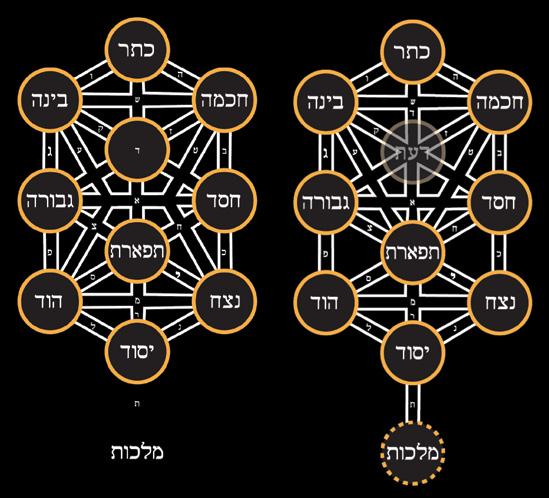
Since the circle itself separates the paradoxically finite interior from G-d’s infinite exterior – or “the waters which were under the firmament from the waters which were above the firmament” – the void was then able house the universe – so G-d set the cornerstone of the world, or olam (from the Hebrew root elem meaning “concealment”). Another way of stating this paradox is that creation had to be circumscribed “within due bounds” of G-d’s limitless and all-powerful light.
From beyond the Heavens (outside the circle), G-d then drew down a narrow beam of his own infinite light, called Kav Ain Sof (like water through a straw) into the “center” of the vacuum. In the Lord’s Prayer, this concept of drawing down G-d’s infinite light may be found camouflaged within the prose “on Earth [inside the circle], as it is in Heaven [outside the circle]” – likewise, in Hermetic doctrine, the philosophy provides “as above [outside the circle], so below [inside the circle].”
When G-d first attempted to pour His infinite light into the vessels, or Hebrew letters, that He created, they shattered because His light was too powerful to be contained by them (the “shattering of the vessels,” or Shevirat HaKelim).
Afterwards, G-d determined to successively narrow His limitless light into a line or (laser?) beam to minimize the amount of light/energy that the beam could carry. Ultimately, the light of G-d reached its destination at the “bottom” of Jacob’s metaphorical Ladder – conceptually interchangeable with spermatozoa fertilizing an egg. Kabbalists will recognize this descent of G-d’s light as the emanations from the Ain Sof Aur (G-d’s limitless light, “Endless Light”) to the four Kabbalistic worlds that make up the Tree of Life/Lives, or Etz Chaim.
The last emanation (Sephirah) or attribute of G-d on the Tree of Life is known to Kabbalists as Malkuth, or “the Kingdom.” Like the Hermetic archetypes above, “the Kingdom” of Malkuth also makes an appearance in the Lord’s Prayer – “for thine is the Kingdom” – which refers, Kabbalistically, to G-d’s infinite light coalescing into four “Earthly Kingdoms” – mineral, plant, animal, and man. For this reason, the Earth/Malkuth may be portrayed as a point-within-a-circle macrocosmically and a cross-within-acircle microcosmically – again, because the cross divides the Sephira Malkuth into four kingdoms.
VOL. 40, NO. 1, 2023 25
Continued on page 304
A SOLEMN OBLIGATION: THE TRUEST LENGTH OF A MASONIC CABLETOW
by Winston Sale | Senior Deacon, Temple-Noyes-Cathedral Lodge No. 32 & Robert Heffelfinger, III, PM | Hiram-Takoma Lodge No. 10
TTo become a Master Mason, every brother must take upon himself a solemn obligation consisting of a series of promises pertaining to the preservation and promotion of our grand brotherhood. One of the most significant of these promises is to swear that if called, you will provide relief to another brother in danger if the probability of saving his life is greater than that of losing your own.
This concept is noble, but not ordinarily interpreted as a literal obligation to endanger oneself for the sake of a brother. However, if the time comes where you are presented with the call to assist, where a fellow brother’s life hangs in the balance, how would you respond?
The following story is of such an event, where kidney disease brought two brothers together in a profound way and changed both of their lives for the better.
On a warm spring evening in 2021, Rob Heffelfinger (PM, Hiram-Takoma) joined a few friends from Temple Noyes Cathedral Lodge No. 32 (commonly known as “TNC32”) for socially-distant drinks on the porch of TNC32 Junior Deacon Winston Sale’s house. Still in the waning grip of the pandemic, the conversation covered standard topics of
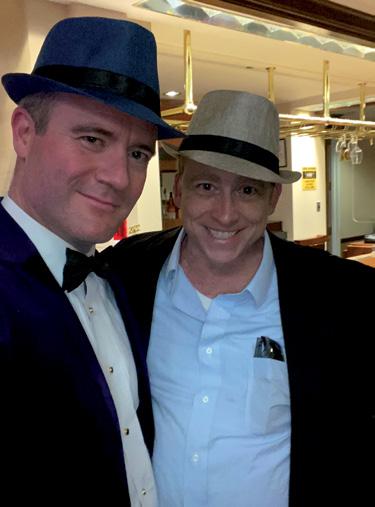
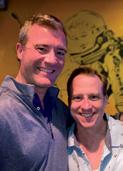
the time - the challenges of remote work and school, friends and family who had contracted COVID, and the charity work of Masons around the jurisdiction. As libations flowed and the evening wore on, the conversation turned to Rob’s health and he shared his struggles with poly-cystic kidney disease, sometimes referred to as “PKD.”
PKD is a hereditary illness that causes uncontrollable cyst growth in the kidneys. These cysts slowly degrade kidney function until they are no longer able to effectively filter toxins from the blood, leaving the sufferer with two options for survival - dialysis or a kidney transplant. This phase of the disease is ominously referred to as “end stage renal disease.”
PKD often manifests in early adulthood and can be a devastating surprise for those unaware of a family history of the disease. Progression varies, but many sufferers reach end stage renal disease in their early forties. Prior to the invention of kidney dialysis in 1945, and then the kidney transplant procedure in 1954, PKD was effectively a death sentence by middle age. PKD remains an existential health concern for all those who are unfortunately afflicted.
THE VOICE OF FREEMASONRY 26
Bro. Sale and W. Bro. Heffelfinger
Rob’s TNC32 friends that evening, including Winston, were only vaguely aware that he had kidney problems. Over the course of their conversation that evening, Rob explained his illness and that his kidney function had been substantially reduced as they were ravaged by cysts, and how because of his disease his kidneys had grown immensely in size. His jolly beer belly was actually a symptom of his disease, his kidneys had grown so large that they were pushing his organs into his abdomen, causing pain and derivative health issues such as gastrointestinal and blood pressure problems.
At that time, Rob had not yet been placed on the transplant list because his degrading kidneys were still able to keep him alive. Rob explained to his friends that he could receive a kidney from either a living or deceased donor and that the primary qualification for donor eligibility would be to share Rob’s blood type, that being A positive. Rob was optimistic that he would be placed on the transplant list and eventually receive a cadaver donor, a wait that could take up to five years.

As Winston listened to Rob that evening he reflected on the fact that he had never asked about his illness. He had no idea that Rob’s condition was so precarious, or that his life could be dramatically extended and improved with a kidney transplant. Thanks to a history of frequent blood donation Winston knew he shared Rob’s blood type, but he made no mention of it, afraid that he might be pressured to donate. However, the conversation left a deep impression and a sense that he had some work to do.
Over the next two years Washington slowly emerged from the pandemic and daily life returned to a version of pre-COVID normal. Winston and his wife, Kate, grew increasingly busy with their careers in the federal government and with raising their two daughters, Sophia (11) and Savannah (8). Winston had not forgotten the conversation with Rob, however, and began educating himself on kidney disease, dialysis, and transplant.
Through this research, Winston learned that only one kidney is needed for survival, and that about one in one hundred people are born with only one functioning kidney. The vast majority of living kidney donors go on to lead a normal, healthy life with few limitations and their statistical life expectancy is longer than the average population because one must be very healthy to donate.
Donor surgery is laparoscopic, typically requiring only a two-night stay in the hospital and most people can return to office work in two weeks. Approximately 20,000 kidney transplants are performed in the United States per year and the procedure has become exceptionally safe. The risk of mortality associated with a live donation is approximately on par with that of giving birth – a risk Winston’s wife had already borne twice. Unfortunately, however, over 100,000 Americans are in need of a kidney transplant and dozens on the waiting list die everyday due to complications from their disease or dialysis.
Armed with this knowledge, Winston began to question why live kidney donation was not more common given that it is a life-saving therapy with so few drawbacks, and whether he might medically qualify as a donor for Rob. He discussed the idea with his wife, who was initially quite concerned with the proposal, but came to support it when she, too, learned the facts about living kidney donation. Winston ultimately decided that if Rob’s health degraded such that he would need dialysis to stay alive he would begin the donation screening process in earnest.
During this period Rob continued to suffer complications and setbacks related to his PKD. In addition to chronic pain and constant doctor visits, one of the more insidious effects of reduced kidney function is increased toxins in the blood. These toxins affected Rob’s brain function and behavior
VOL. 40, NO. 1, 2023 27 Continued on next page4
Bro. Sale stands in front of transplant numbers
to the point that some acquaintances who were unaware of his disease speculated that he might be using illegal drugs. Finally, in December 2022, just a few days before Christmas, Rob’s kidneys suddenly stopped functioning at a life-sustaining level and he was rushed to the hospital for emergency dialysis.
Winston was closing a few year-end work projects before a much needed holiday vacation when he received a text message saying that Rob was in the hospital and starting dialysis. Winston thought of Rob’s wife, Leslie, and their son, Benny (only six years old at the time), and how difficult this time must be for their family, especially with Christmas just a few days away. Suddenly overcome by emotion, he realized this news presented a test of his fortitude –did he have the courage to follow through on his stated conviction, to begin the screening process to become a living kidney donor?
The next day, Winston and friend Geoff Newman (Mountain No. 99 in Frostburg, Maryland) visited Rob in the hospital. Seeing Rob’s poor condition and his wife’s distress, the gravity of the situation suddenly came into clear focus for Winston and the choice to donate no longer felt like a choice at all. Rob needed a kidney, Winston could potentially provide one at relatively small cost to himself, and without it, Rob would likely suffer on dialysis for years. In an emotional moment for all, the words tumbled from Winston’s lips, “Rob, I want to try to give you a kidney. Where do I start?”
Rob had been receiving specialized kidney care at Johns Hopkins Hospital in Baltimore, so on the first business day of 2023, Winston contacted Johns Hopkins’ Comprehensive Transplant Center to begin the donor screening process. The first step was to complete a written application covering medical information, family health history, and an explanation of why he wanted to donate. This was followed by a blood screening to confirm that he had a matching blood type, acceptable lab work, and no blood-borne diseases that could infect Rob from the transplant.

Having passed the first step in the screening process, Winston drove to Johns Hopkins in March for a full day of comprehensive health testing and conversations with the transplant team. Tests included a cat scan, chest x-ray, EKG, and more blood tests to verify that Winston and Rob would likely be a good genetic match - an important factor in reducing the likelihood of transplant rejection. Winston also spent several hours talking with a surgeon, nephrologist, and social worker about the donation surgical procedure, recovery process, medical risks, and
psycho-social concerns such as who would provide care after surgery. As a federal employee, Winston was eligible for 30 days of special organ donation leave and knew that his wife would be able to care for him during recovery.
In May, the transplant team at Johns Hopkins informed Winston he was in excellent health and approved to donate a kidney to Rob. Soon after, Rob’s kidney care team approved him to receive the transplant. Before that
THE VOICE OF FREEMASONRY 28
Prepping for surgery

could happen, however, Rob had to have his sick kidneys removed.
By this time, Rob was on dialysis for four hours per day, three days per week, and his sick kidneys were causing significant health issues. In July, through an ordeal of a surgery, Rob’s kidneys were removed. Grossly enlarged by PKD, they weighed 35 pounds together and each was the size of a football (for reference, a healthy kidney is usually the size of a fist). With this step complete, the transplant surgery was scheduled for September 21st. To survive without kidneys, Rob would have to continue on regular dialysis until then.
On transplant day, Winston, Rob, and their wives arrived at Johns Hopkins before sunrise. Winston was first to go into the operating room and in a four hour, robot-assisted laparoscopic surgery, his left kidney was removed without issue. The surgeon later told Rob that it was “a beautiful kidney.” After a successful six hour transplant surgery, Rob and Winston were recovering in rooms in the same hall of Johns Hopkins’ transplant wing.
Although the few first days post-surgery were challenging, Winston recovered rapidly and felt well enough to attend a concert only two weeks after the donation. Rob’s recovery
was less smooth, with a few complications that required additional time in the hospital, but his new kidney was working well enough that he no longer needed dialysis. As of the time of this writing, Rob’s new kidney is working well and Winston has had no complications.
By participating together in a modern medical miracle, Rob, Winston, and their families have become closer friends. Reflecting on the magnitude of these events, Winston feels a deep certainty that his donation, despite its challenges, was one of the most meaningful actions of his life and has retained a sense of confidence and satisfaction long after surgery. Meanwhile, Rob continues to recover and is looking forward to returning to a normal life raising his son without the specter of illness and dialysis looking over his shoulder.
Entered Apprentice Masons are taught that to relieve the distressed is a duty particularly incumbent on Masons, who are linked together by an indissoluble chain of sincere affection. To soothe the unhappy, to sympathize with their misfortunes, to compassionate their miseries, and restore peace to their troubled minds, is the great aim Masons have in view. On this basis Winston and Rob solidified their friendship and cemented their connection, exemplifying the very best of what our grand fraternity stands for.
VOL. 40, NO. 1, 2023 29
The Heffelfinger and Sale families together
THE TZIMTZUM PARADOX: KABBALISTIC ORIGINS OF THE CIRCUMPUNCT
Continued from Page 25
From the microcosmic vantage point, then, several other “points-within-circles” may be observed that relate directly back to the Lurianic tzimtzum cosmogony. First, the alchemical symbol for gold is identical to the above-mentioned points-withincircles and, further, the word for gold in French is or, from the Latin aurum. As previously noted, or/aur[um] translates to “light” in Hebrew which, according to the law of correspondences, indicates a relationship between that “sol-ar” metal and G-d’s divine light, or Ain Sof Aur.
Second, the point-within-a-circle has been an astrological glyph for the sun since time immemorial and, in French and Spanish, the word for sun is sol, from the Latin solis. Pronounced identically, it’s this “soul/sol of G-d” which, according to the eighteenth-century Tanya, animates the world, in varying degrees, depending on which kingdom is inhabited by the Ain Sof – in other words, animals and plants contain more of G-d’s soul/sol (life force) than do minerals.

Reflecting back on breadcrumbs secreted within the Book of Genesis, worthy students may now unearth the circumpunct’s occult lineage within Freemasonry and other Orders. Based on the Ari’s tzimtzum cosmogony, is it still possible that, in the microcosm, the point-within-a-circle represents the individual Brother and his duty to G-d? Yes! Or is it possible that, in the macrocosm, the point-within-a-circle represents G-d’s unrevealed essence which, only later, manifests its light as that microcosmic Brother? Yes! This is the beautiful paradox of tzimtzum –both may be true!
Further, when combined with the Sepher Yetzirah’s cosmological model, tzimtzum becomes the foundation of a cosmogony centuries ahead of its time and entirely consistent with modern Big Bang theory occulted within the Book of Genesis and Masonic ritual.
Truly, tzimtzum is the foundation of a medieval Theory of Everything! Whether modern students of Kabbalah view tzimtzum as literally as the Ari, after thoughtful reflection, the contemplative Brother finds himself grappling with those age-old questions posed initially by G-d to Job:
“Where were you when I laid the foundations of the earth? Tell Me, if you have understanding Who determined its measurements? Surely you know! Or who stretched the line upon it? To what were its foundations fastened? Or who laid its cornerstone, When the morning stars sang together, And all the sons of God shouted for joy?”
Baruch Hashem!
Works Cited:
1. Book of Genesis
2 . Book of Job
3. Etz Chaim, Rabbi Chaim Vital
4. Physics of Tzimtzum I & II, Dr. Alexander Poltorak
5. Sepher Yetzirah
6. Tanya, Rabbi Shneur Zalman of Liadi
7. Zohar
THE VOICE OF FREEMASONRY 30
W
A LEGACY IN WORLD JAZZ HERITAGE: AFRO-AMERICAN JAZZ AND INFLUENCE OF FREEMASONRY
Wby Emil M. Hasanov | Grand Master of the National Grand Lodge of Azerbaijan
When we delve into the roots of jazz, our thoughts naturally turn to the USA, and the names of jazz pioneers immediately spring to mind:
• Louis Armstrong - Jazz Musician
• Count Basie - Composer, Orchestra Leader
• Irving Berlin - Entertainer
• James Herbert "Eubie" Blake - Composer and Pianist
• Nat "King" Cole - Great Ballad Singer and Pianist
• Edward Kennedy "Duke" Ellington - Composer, Arranger, Pianist, and Orchestra Leader
• Lionel Hampton - Composer and Orchestra Leader
• William C. Handy - Composer "Father of the Blues"
• Al Jolson - Actor of the first talking picture (Jazz Singer)
• Glenn Miller - Orchestra Leader
• Adolphe Joseph Sax - Inventor of the musical instrument saxophone
• Paul Whiteman - Orchestra Leader "King of Jazz"
What is common among them? They are all musicians, and more specifically, jazz musicians.
Let's take a brief journey back to the history of jazz. In the latter half of the 19th century, jazz originated in the vibrant port city of New Orleans, where people from around the world gathered to share their culture,
music, and spirit. Notably, New Orleans was the only city in America that allowed slaves to own drums at that time.
The musical traditions of West Africa, the birthplace of many slaves, found resonance in the songs and field chants of America's slaves. Following the abolition of slavery and the end of the American Civil War in 1865, former slaves found employment as musicians, exposing them to a variety of musical styles from around the world. Jazz was born into this new world of emancipation and freedom, fostering a spirit of experimentation and expression that would become fundamental to jazz.
Jazz drew inspiration from West African musical traditions and combined elements of slave songs and Cuban-style rhythms with European musical influences, resulting in a fusion of chords and a diverse array of musical instruments.
In the 1920s, jazz gained popularity in the USA and Europe, propelling black musicians such as Louis Armstrong, Duke Ellington, and Count Basie to overnight success. Jazz reached its zenith with the historic 1938 Benny Goodman concert at Carnegie Hall, which brought

VOL. 40, NO. 1, 2023 31
Continued on next page4
Art Kane, "Harlem 1958" Photo: Art Kane
together musicians from various ethnicities to perform jazz within this revered venue.1
One of the important points is that the jazz music of African immigrants made a tremendous impact on the musical culture of the 20th century, resonating with people across South and North America, Africa, Asia, and Europe. In just 100 years, jazz developed to a level that paralleled 700 years of European music.
As a result, this music of America became the universal sound and language of humanity while maintaining its roots back where it originated.
“It has long been considered jazz’s most iconic and triumphant image. Photographed by Art Kane, “Harlem 1958” captured 57 jazz greats gathered on the stoop of a Harlem brownstone and on the sidewalk below. Staged loosely as a “class photo,” the image cast jazz musicians in a fresh light and marked a turning point in how jazz was viewed and appreciated. Now known as “A Great Day in Harlem,” the photo was taken on Aug. 12, 1958, and originally appeared in Esquire magazine in January 1959.2”
ensemble members. Over the years, many musicians joined or departed from his group, prompting Duke to adapt and rewrite his music to complement the talents of his new members. This adaptability made him an enduring source of inspiration and a guiding light for countless musicians throughout his lifetime.

SPREADING BROTHERLY LOVE
Although Prince Hall musicians rarely discussed their Masonic friendships publicly, a strong sense of camaraderie is evident in the era's photos and videos, showcasing the unity of brothers as they performed together. Duke Ellington, a member of Social Lodge No. 1 in Washington, D.C. and a 32 Scottish Rite Prince Hall Mason, subtly acknowledged his Masonic connections by wearing a Shriner's fez in his autobiography. The close bonds among these musicians were also apparent to non-Masons, as exemplified by Louis Armstrong, who fondly recalled in his autobiography his enthusiasm for performing at Masonic funerals.
Duke Ellington's orchestra stood as the foremost jazz group of its time. Duke consistently composed music that showcased the exceptional abilities and creativity of his
In his autobiography, "Bass Line," Milt Hinton, renowned as "the Dean of Jazz Bass Players," offered valuable insights into the strong Masonic friendships enjoyed by his contemporaries while on the road.
As a member of Pioneer Lodge No. 1 alongside Calloway, Hinton recounted how several musicians in their band prioritized attending the lodge whenever they were in St. Paul. He detailed how they even held their own lodge meetings on the road, conducting readings backstage between shows.
Duke Ellington's contributions brought big-band jazz to global acclaim with hits like "It Don't Mean a Thing If It Ain't Got That Swing." This 12-time Grammy-award-winning artist was a member of Social Lodge No. 1 in Washington, D.C.3
THE NEW MUSIC WAS CALLED JAZZ
A few hundred years ago, immigrants from old Europe and Africa brought their values and aspirations for fraternity and equality, giving rise to new nations and states. They envisioned a utopian society—a paradise state, a heavenly state, or Tommaso Campanella's "The City of The Sun." These immigrants converged in North America to establish a new state founded on equality and the spirit of brotherly love—a new ideal Masonic state.
This same spirit extended to music, giving birth to jazz—a new, spiritual, and revolutionary musical phenomenon rooted in improvisation. The essence of jazz was epitomized in the "jam session," a unique and spontaneous musical gathering that brought forth a spirit never to be replicated. The jam session was exclusive to jazz, performed by a band and embraced by musicians in harmony with themselves.
1 Jazz Observer, a passion for music & travel. History -the Origin of Jazz. https://jazzobserver.com/the-origins-of-jazz/
2 The Wall Street Journal, ESSAY A Great Day in Harlem, Revisited Sixty years ago, an iconic group photo changed the way Americans thought about jazz By Marc Myers Nov. 2, 2018, 10:24 am ET, https://www.wsj.com/articles/a-great-day-in-harlem-revisited-1541168693.
3 The Masons of Jazz, Deep Masonic Friendships Connected the Giants of Jazz by Michelle Simone https://californiafreemason.org/2019/04/01/the-masons-of-jazz/
THE VOICE OF FREEMASONRY 32
The term "jam session" traces back to the 1920s when white and black musicians congregated after their regular paying gigs to play the jazz, they couldn't perform in the style bands they were part of. These sessions, attended by the likes of Bing Crosby, became known as "jam sessions."
In a short span, the United States emerged as the world's leading prosperous and developed republic, embodying the principles of equality, fraternity, and liberty—foundational values that materialized into everyday realities for ordinary citizens long before they were adopted in the old continent following the French Revolution.
The evolution of jazz has been remarkable, marked by the emergence of diverse stylistic eras such as Ragtime, Boogie, New Orleans, Dixieland, Swing, classical, and bebop. Today, we witness new influences and styles shaping jazz music, reflecting its status as a continuously evolving art form.
Jazz's development has been characterized by its openness to different cultural influences while simultaneously nurturing and enriching those cultures. This has rendered jazz a truly universal music form for humanity.
At present, defining the concept of jazz has become a challenging task. Jazz has transcended technical definitions and is now universally regarded as an expression of lived experiences through sound.
In 1957, U.S. President Dwight D. Eisenhower appointed Hampton as "American Goodwill Ambassador," and this appointment was extended by President Richard Nixon. Over the years, Hampton and his orchestra embarked on numerous tours across Africa, Asia, Europe, and the Middle East, sharing their music and immersing themselves in the cultures of the world. A document in the U.S. National Archives describes Hampton's journey to the "Far East," highlighting his unique ability to connect with people and engage with the Thai public through music workshops, performances for the Royal Household, and city tours.
Hampton once remarked, "Gratitude is when memory is stored in the heart and not in the mind." It is this sense of humility and gratitude that appears to link the legacies of these esteemed Masonic artists. Each of them achieved remarkable personal success, bound together, and uplifted by the bonds of brotherly love they shared. It was an internal force—a source of strength to move forward, coupled with an obligation to carry their brothers with them. As Hampton aptly put it, "Being a Mason is a sacred thing."

The words of jazz maestro Duke Ellington resonate deeply: "In the future, there will not be jazz; there will only be good music and bad music."
This original American music has evolved into the universal language of humanity, reflecting, and reviving the very roots from which it originated.
Prince Hall musicians also drew upon their Masonic values of tolerance and respect while traveling to perform for audiences around the world. As jazz music gained nearuniversal popularity, its musicians often played a key role in fostering diplomacy. A notable example is Bro. Lionel Hampton, also known as "the King of the Vibes." While he initially gained recognition for introducing the vibraphone to jazz music, it was his exceptional talent as a composer and arranger for the self-titled Lionel Hampton Orchestra that solidified his global reputation.
Delving into jazz history in the USA reveals the strong connections between jazz and freemasonry. Duke Ellington was among the many renowned African American musicians associated with this spiritual and enigmatic group, which also included Nat King Cole, WC Handy, Dizzy Gillespie, Count Basie, Lionel Hampton, and Paul Robeson. In the 18th century, "the Lodge of the Nine Muses" attracted European musicians, including Mozart and Bach. A century later, a similar phenomenon occurred in the USA. However, at that time, freemasonry in America was segregated and divided along color lines.
Prince Hall (1735-1807), a leather worker, faced rejection when he sought admittance to the St John’s Masonic Lodge in Boston, Massachusetts. Undeterred by this setback, Hall and 14 other free black men were initiated into freemasonry in 1775 by a British military lodge based in Boston. Following the departure of the British from America in 1784, the Grand Lodge of England granted Hall a charter to establish an African lodge in Boston. The lodge gained immense popularity, leading to Prince Hall being appointed as provincial grand master, enabling him to establish two additional African masonic lodges in Philadelphia and Rhode Island. Since then, Prince Hall Continued on next page4
VOL. 40, NO. 1, 2023 33
Freemasonry has evolved into the world’s largest fraternity of black men and, by the mid-20th century, had spread to Prince Hall Masonic temples across the USA, from Los Angeles to Washington DC, and from Seattle to Madison, Wisconsin.
During the early 20th century, a time when Americans were inclined to join various organizations, Prince Hall Masonry became a platform for politicized African Americans. By 1900, it had attracted prominent figures such as Booker T. Washington (1856-1915) and W.E.B. Du Bois (18681963) as active members. Throughout the 20th century, many key figures in the civil rights movement were drawn to freemasonry. Martin Luther King Sr (1900-84), the father of Martin Luther King Jr, was a member of the 23rd lodge in Atlanta, Georgia. Medgar Evers, the activist of the National Association for the Advancement of Colored People (NAACP) who was assassinated in 1963, held the rank of 32nd-degree freemason in the Ancient & Accepted Scottish Rite, Southern Jurisdiction. Alex Haley (192192), the author of "Roots" and biographer of Malcolm X, was a 33rd-degree mason in the same order. Thurgood Marshall (1908-93), the first black member of the US Supreme Court, was supported by his Prince Hall lodge in Louisiana.
The influence of Prince Hall lodges extended to various fields, as seen in the involvement of comedian Richard Pryor (1940-2005), actor and activist Ossie Davis (19172005), Paul Robeson (1898-1976), and boxer Sugar Ray Robinson (1921-1989) as active members. These lodges served as a platform where pre-Christian knowledge could freely intersect with black liberation theories and remnants of African religions and Egyptology. This connection to freemasonry is rooted in the 1954 book "Stolen Legacy" by Afro-Guyanese historian George GM James, who was a Prince Hall mason and a professor at the University of Arkansas.4
DO WE FIND OURSELVES CONSTANTLY QUESTIONING, "WHAT IS FREEMASONRY?"
Freemasonry is an institution that promotes culture and progress, fostering love and cooperation among individuals of high moral values. It plays a role in the social and cultural development of humanity, emphasizing the importance
of work and labor as fundamental human duties. Respect for individuality and tolerance for diverse opinions are foundational principles within this institution. Freemasons prioritize personal development to contribute to the progress of society.
A Freemason embodies the essence of perpetual contemplation, consistently birthing new ideas while critically examining established ones. This dedication to ideation serves as the cornerstone of modern society, shaping its fundamental fabric.
In the realm of freemasonry, the cultivation of innovative thoughts stands as the driving force behind the evolution of society. It is this unwavering commitment that compels Freemasons to continually explore and develop new perspectives on the allegories and symbols presented to them.
Freemasonry, as both a science and an institution of initiation, beckons its adherents to leave behind their former lives and embark on a path toward an elevated and noble existence. It symbolizes a journey of unceasing advancement and growth. Within this community, individuals of merit and faith are united by a universal bond of brotherhood, fostering an environment where tolerance for one another's fallibilities, imperfections, and vulnerabilities is cultivated. In the realm of freemasonry, racial and linguistic distinctions hold no sway, as all brothers are equal in their pursuit of enlightenment and unity.
The common thread among these individuals is their shared commitment to Freemasonry, promoting a culture of cooperation, personal development, and the exchange of ideas.

The Afro-American Freemason jazz musicians have made significant contributions to Freemasonry, American heritage, and world heritage through their focus on personal development, collaboration, and the exchange of innovative ideas. Their participation in Freemasonry reflects a dedication to unity, enlightenment, and the nurturing of diverse perspectives. Their artistic expression and cultural influence have left a lasting impact on the musical landscape, enriching both American and world heritage with their unique contributions.
4 The secret history of the jazz greats who were freemasons. https://ann.az/en/the-secret-history-of-the-jazz-greats-who-were-freemasons/ theguardian.com,03 April 2014
THE VOICE OF FREEMASONRY 34
F
THE POSITIVE IMPACT OF TECHNOLOGY ON MASONIC PRINCIPLES
Fby Boğaç Çetiner, PM, Nur Lodge
Freemasonry with its rich history and timeless values, today faces a technological world that offers powerful tools to augment our dedication to the core principles of Brotherly Love, Relief, and Truth. Technology is not a replacement for our cherished protocols and traditions, but rather a complementary force that can enrich and protect our experience.
Just as our masonic ancestors utilized the cutting-edge tools of their time to construct architectural wonders, we too can leverage technology to enhance efficiency and accuracy, within our lodges, while always being careful to not innovate the nature of our craft, but rather bolster our existing practices through technological means.
Brotherly Love can be strengthened by embracing tools that simplify lodge operations, allowing us to dedicate more time to fostering meaningful connections with our brothers, ultimately leading to a more harmonious and fulfilling lodge experience.
records by globally renowned research lodges has opened a treasure trove of knowledge and historical documents to brethren worldwide. This accessibility enriches the understanding and engagement with our heritage, empowering our journey toward enlightenment and a deeper embodiment of Masonic principles.
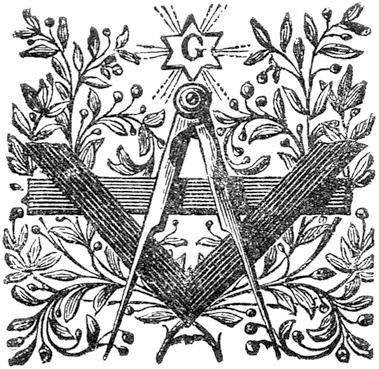
However, as we navigate this digital world, we must remain vigilant guardians of our brothers' privacy and security, just as the Tiler guards the West Gate of our lodges. Implementing robust security and screening measures is essential to protect our fraternal integrity and ensure the inviolability of the bonds of brotherhood. Therefore, adopting comprehensive security practices is paramount. This includes technical measures like data encryption, as well as organizational safeguards such as well-defined policies and security practices. By cultivating a culture of security within the organization, we can ensure the confidentiality and integrity of our Craft.
Relief efforts are amplified through digital platforms, empowering us to reach a wider audience and maximize our impact. These platforms serve as catalysts for meaningful partnerships and collaborative efforts, allowing us to embody the principle of relief in a more effective manner.
The pursuit of truth and enlightenment lies at the heart of Freemasonry. The digitalization of Masonic texts and
By embracing technology cautiously and thoughtfully, just as we take our first steps into our temples, we can elevate our craft and preserve it for future generations. May Freemasonry continue to illuminate the world with the principles of Brotherly Love, Relief, and Truth, guided by the pillars of wisdom, strength, and beauty.
VOL. 40, NO. 1, 2023 35
THE DEVELOPMENT OF LODGE IDENTITY
Eby Shawn Eyer | Grand Provost
Every institution projects an identity through its social and artistic interface with the wider community. This cultural interface has a strong influence on how any institution is perceived. Not just Freemasonry as a whole, but every Masonic lodge has a cultural identity, composed of how it represents itself, and how others represent it. This article is intended to assist those lodges that wish to more actively address issues of institutional identity.
A Lodge is, as every ritual teaches, its members. Our comportment as Masons ultimately determines the character and identity of our Lodge, at a personal level. But what about the impersonal level? The level at which a brother might know our lodge not through personal contact with the membership, but through its imagery alone?
The identity of our Lodge on paper—its name, its emblems, its motto—will be the first impression that most of your fellow Masons will experience. It will also be an important part of the framing of the Masonic experience of our applicants. For many Masons, it will be their only experience of our lodge.
Bearing this in mind, one may begin to recognize what a great opportunity presents itself to any lodge when it consciously develops its public identity. Skillfully designed and properly arranged, all of the interconnected elements of that identity will reinforce one another and effectively express your lodge’s vision and its ideals.
Meanwhile, allowing the lodge’s identity to be poorly expressed, or randomly changed, will always degrade how it is perceived both internally and externally. Even were there no “marketing” aspect of improving a lodge’s institutional identity, the matter still would deserve attention out of a general sense of propriety and in accordance with the teaching that there should be wisdom to contrive, strength to support and beauty to adorn any great and important undertaking.
RECOMMENDED PROCESS
This document is designed to prepare any lodge for a threestage process of developing or redeveloping its identity. The final section will be a workbook-style guide to take our project through the process step by step. Here is a quick
summary of the stages and what they entail.
First Stage. The lodge or forming lodge members meet as a group for a brainstorm session. The essential traits of the lodge moving forward are recorded. Key concepts emerge, which are then recast using terms and symbols from Masonic tradition. Possible names and visual concepts organically emerge. No binding decisions are made at this time.
Second Stage. Using ideas that appeared in the first stage, each interested member, working on his own, develops a prospectus which contains a suggested lodge name, drafts of a suggested emblem and seal, suggested motto (if desired), and an essay supporting the proposed elements.
Third Stage. The group reconvenes and considers each prospectus, if there is more than one. If there is a clear leader, it is ratified and then refined into its mature form, ready for use. If no prospectus is a clear leader, further development is done on each of them until one becomes the obvious choice.
BRAINSTORMING IDENTITY CONCEPTS
Consider starting out with a brainstorm session. First, jot down the core concepts and values about Freemasonry that you would like our lodge to embody. These don’t have to be terms suitable for naming the lodge, but they will help as you work together to frame our overall concept.
Here is the result of such a brainstorming session:
discoverydignityexploring Masonry journeyinitiation
buildinggivingintegritywelcominghonoring tradition
wisdomwholesome instruction hard work charity for all ages
THE VOICE OF FREEMASONRY 36
stabilityimpactteachingquality excellent ritual protecting harmony reverencelearning together seeking enlightenment respect brotherly love & affection mysteryspiritualequality well organized
profoundcaring moral truthmale bonding solemnity
Right away we see that while “learning together,” “male bonding,” “excellent ritual,” and “well organized” would make terrible lodge names, they could be suggestive concepts to express the ideals of what a lodge would like to provide. Such idea-clusters are very helpful at zeroing in on the overall sense of the lodge’s vision. This gives us a great place to start, without getting prematurely committed to any one name or idea.
Once a core concept begins to emerge, and preferably after the lodge’s imagery has also been considered (see the section on the Emblem and the Seal, below), then we are on better grounds for proposing a name for the lodge.
I. NAMING THE LODGE
“To begin well is the most likely means to end well.”— William Preston, Illustrations of Freemasonry
Both the naming of a new lodge and the renaming of an existing lodge should be done with the most deliberate care. After all, we are making something that is intended to outlive us. In all elements of the identity design process, personal egos and rank should be set aside and ideas should stand on their own merit. But this is especially when considering ideas for a name. A name can say much (or little) about the lodge, and can help or hamper the overall mission of the association.
restrained approach is strongly recommended. Simply put, it is easy to get “married” to a name too fast. In fact, this is often the most significant danger in the formation of a lodge identity.
Think long term. Lodge names are (rightfully) hard to change—in fact in some jurisdictions they cannot be changed at all after the lodge is chartered. Choose wisely.
Capture the essence. As modern people we often think of a name as just a label. But traditionally, names are understood as references to the essential character of a person or group. Let your name flow from that essential character, rather than your essential character flow from your name.
Consider the reactions of others. Imagine how others—both Masons and non-Masons—will react to your lodge’s name. Institutional identity is not unidirectional. We cannot dictate it. Instead, those outside our lodge will perceive the name through their own “lenses.”
Don’t default to place. Your lodge may be in Newfoundtown, but it need not be called “Newfoundtown Lodge.” However, references to your lodge’s locale or local traditions may be desirable if they can be coordinated with Masonic ideas (see
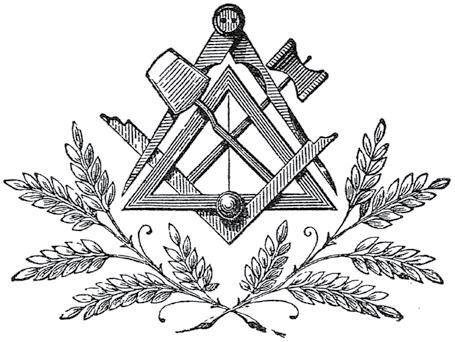
BASIC PRINCIPLES FOR NAMING
A few simple guidelines can strengthen our efforts and help avoid common mistakes:
Avoid Premature Commitment to a Name. While starting with a great name and then developing the other elements described in this kit might be a workable method, a more
The Masonic tradition includes thousands of symbols. Terms and phrases from our ceremonies provide a rich and meaningful vocabulary which might be incorporated into a
Combine ideas carefully as appropriate. It may be fitting to combine the concrete with the symbolic tradition. A simple example would be “Appleton Compass Lodge,” where Appleton is the locale, and Compass the Masonic element of the identity. If our lodge name draws from either locale or the name of a famous worthy brother, it is still possible to combine meaningful terms from the tradition in order to enrich the name.
Avoid mere duplication. We should not use this opportunity just to copy another lodge’s name, whether that lodge is current or historical. Consider a meaningful variation instead. If there is a lodge whose name your members like, Continued on next page4
VOL. 40, NO. 1, 2023 37
say “Pythagoras Lodge,” why not suggest “Pythagorean Harmony Lodge” or “Pythagorean Triangle Lodge?” Eliminate confusion with an original lodge name. Above all, avoid duplicating the name of another lodge without first opening a discussion with them, as to do so would run counter to the ways of common courtesy.
EKeep it understandable. Lodge names have traditionally been chosen to conform to the common language of the jurisdiction. Foreign terms (from Greek, Latin and Hebrew) have occasionally been used when they directly pertain to the ritual and are known to the Brethren—these are typically loanwords such as “Ionic,” “Sanctum,” and “Shechinah.” More obscure usage of foreign languages should be carefully examined, however. Will it promote understanding, or contribute to undesired results? “Sapientia Solomonis Lodge” and “Chochmat Shlomo Lodge” are a bit offputting in a way that “Wisdom of Solomon Lodge” isn’t. “Gates of Light Lodge” is inviting, but “Lodge Portae Lucis” or “Lodge Sha’are Orah” may signify a closed door to those who find the name incomprehensible. There is nothing to be gained by having a name that others might find pretentious. Generally, the best place for phrases in Latin, Greek or Hebrew is in the lodge motto rather than in the name itself.
As one can see, there is a lot more to selecting a lodge name than picking one out of a hat. Great deliberation is called for. The process need not be laborious, however. Here are some tips on making the task more engaging.
Four Main Formats for Lodge Names
The Lodge of X The Lodge of Living Stones (Leeds, England)
Lodge X Lodge Vitruvian (Indianapolis, Indiana)
Note that in the case of Latin lodge names, it is generally more fitting to use the last form: i.e. “Lodge Adhuc Stat, U.D.” or “Lodge Veritas No. 1636.”
II. CONSIDERING THE MOTTO
There was a time when any distinctive institution had a motto. A motto is defined as “a brief statement used to express a principle, goal, or ideal,” “a sentence, phrase, or word of appropriate character inscribed on or attached to an object,” and “a maxim adopted as a guide to one’s conduct.” A motto states, very succinctly, an idea which is essential to the identity and mission of an organization.

Although we often default to “[ Name ] Lodge No. [ x ],” there are several other formats which have been used traditionally. We may find that a different format suits the emerging vision of our lodge’s identity:
format examples
X Lodge Guildhall Lodge (Stillwater, Oklahoma)
The X Lodge The Harvard Lodge (Cambridge, Massachussets)
Mottos have a long history within Freemasonry and the thoughtful use of one can lend a lot to your institutional identity. The motto that appeared on the seal of the original Grand Lodge was
(Greek, En arkhê ên ho logos, “In the beginning was the word.”_John 1:1). The original motto of the Antient Grand Lodge (the second GL that formed) was “Virtue and Silence.” This was later replaced by a Hebrew motto, קדש ליהוה (kodesh l’yhvh), “holiness to the Lord,” which remains one of the most widely used mottos on Grand Lodge seals worldwide. *NOTE TO TYPESETTING: I need to review the foreign language above prior to print to ensure they came out right. In Adobe the “World-Ready Paragraph Composer” must be used for the Hebrew to work.*
Institutions in English-speaking lands sometimes use English for their motto, but more commonly use a classical language. Latin is by far the most popular, with Greek and Hebrew as distant seconds and thirds. There are many reasons for this choice. First, many of the most honored concepts originated in or were transmitted to us via those languages. Second, the prudent use of ancient languages lends an air of dignity
THE VOICE OF FREEMASONRY 38
ΕΝ ΑΡΧΗ ΗΝ Ο ΛΟΓΟΣ
to a design. And lastly, in any such design, space is limited. Ancient languages tended to be terse, requiring fewer words to say more. An obvious example of this efficiency is the Latin fiat lux, which in English is “Let there be light.” English nearly always uses more words, and more syllables.

What makes for a good lodge motto. An appropriate lodge motto is one which has a ready thematic echo in the Masonic ritual tradition. Sections of Biblical passages that are cited or alluded to in the workings are particularly ideal.
Some may object to the adoption of a motto on the grounds that it is too stuffy or old-fashioned. One may as well— on the same grounds—object to the Masonic degrees themselves! We must not allow such cynicism to control any of the decisions relative to the lodge identity. Masonic bodies have optionally had mottos since the fraternity began. Although not required, they are certainly a part of our rich heritage, and the revived use of them today signals an important return to the practices that gave Freemasonry the eminence of reputation that it has enjoyed for centuries.
Mottos not to use. In general, Grand Lodge mottos (such as Audi Vide Tace, Holiness to the Lord, etc.), and mottos associated with higher degrees or appendant bodies (Sapientia, Deus Meumque Jus, etc.) should not be used by Craft lodges. Also, lodges should avoid things like military mottos or mottos which simply express the views of one member. Finally, note that humor or triviality has no place in the motto of a Masonic lodge.
APPROPRIATE CRAFT LODGE MOTTOS
Mottos from Biblical Tradition
fiat lux et facta est lux“let there be light, and there was light” The original Hebrew, in this case, also makes a nice motto when Latinized: yehi aur veyehi aur. sapientia, intellegentia, doctrina “wisdom, understanding and cunning” (1 Kings 7.14) [that is, the three divine qualities that enabled Hiram to create his designs]
frumentum et vinum ac oleum
nam lignum habet spem
“corn, wine and oil” A common phrase used in the Hebrew Bible to refer both to divine blessings and to appropriate offerings to the divine. In Hebrew, dagan ve-tirosh ve-yitzhar.
“for there is hope of a tree” (Job 14:7)
rami non deficient“the tender branch will not cease” (Job 14:7)
cælum præ altitudine et terra præ profunditate
quasi stellæ in perpetuas æternitates fuerint
et maiestas Domini implevit domum
“the heaven for height, the earth for depth” (Proverbs 25:3) This phrase connects to the Masonic tradition, expressed in the first degree, that the lodge has the vault of heaven for its height and the center of the earth for its depth.
“they shall shine as the stars forever and ever” (Daniel 12:3) A phrase familiar to Master Masons in most jurisdictions. To make it shorter, omit fuerint (“they shall shine”).
“and the Glory of the Lord filled the house” (2 Chronicles 7.1) igitur aedificavit salomon domum et consummavit eam
“Thus Solomon built the Temple, and finished it.” (1 Kings 6:14) A shorter version: domum ædificavit et consummavit (“he built the Temple and finished it”).
Mala aurea in ornatibus argenteis
verbum prolatum in tempore suo
“Like apples of gold in settings of silver.” (Proverbs 25:11)
“a word fitly spoken” (Proverbs 25:11)
Continued on next page4
VOL. 40, NO. 1, 2023 39
ecce quam bonum et quam iucundum
“Behold, how good and how pleasant it is” (Psalms 133:1) bonum et iucundum, fratres in unum
gloria dei est celare verbum, et gloria regum investigare sermonem
“good and pleasant are brothers in unity” (Psalms 133:1)
“The glory of God, a matter concealed; a matter plumbed, the glory of kings.” (Proverbs 25:2)
Mottos from Classical Tradition
sic transit gloria mundi“So passes worldly glory.”
ΛΑΜΠΑΔΙΑ
“one with a lamp passes it to another” (Plato, The Republic 328a)
Mottos from Craft Lodge Tradition
vide aude tace
virtute et silentio
“know, dare, be silent”
“virtue and silence”
adhuc stat “it stands yet” A Latin motto visible on some European Masonic medallions, associated with the Rectified Scottish Rite. The familiar phrase in the ritual, “Freemasonry, notwithstanding [opposition], has still survived,” is similar in sentiment.
Avoid the Biggest Mistake: Faulty Grammar or Translation. We must ensure that the grammar is correct in our identity elements. Never assume that something is right based on information from the Internet, and do not rely on automatic translations. Unfortunately, there has been a marked increase in grammatical mistakes and translation blunders in Lodge names and mottos, some of which would be comical were they not causing harm to the intellectual integrity of the Craft.
Saying True Things. Ensure that the proper pronunciation is part of lodge culture and is recorded in a way that will not get lost as time passes. “Portae Lucis” is “POR-tai LOO-keese,” but will degenerate quickly to “PORT-tay LOOSH-us,” to the embarrassment of all. Sapientia Solomonis will go from “sahp-ee-ENT-eeah sow-low-MAHN-eese” to “SAPPY-ensha sola-MAN-
iss” before you can say Et tu, Brute.
Getting Help. There is no shame in seeking help. Just don’t seek it from random “experts” on the Internet. There may be legitimate sources for assistance at a nearby university. The author of this paper is happy to provide direct assistance or appropriate reference.
III. THE LODGE EMBLEM
A traditional lodge’s emblem (we discourage the term “logo”) can be a powerful part of its identity. The emblem and the seal are not the same thing. The emblem would appear more frequently: such as on the website, letterhead, lodge banner, or lodge newsletter
The seal would be used almost exclusively on official documents issued by the Master or Secretary of the lodge.
How do the Emblem and the Seal Differ? In many cases, a lodge seal will need to be simplified from the lodge emblem. Seals are embossed and cannot bear the fine detail that printing with ink affords.
If your lodge has a number, don’t pound it. Do not use the pound sign or hash mark (#) for “number.” Use the numero sign (№) most properly, or type “No.” as an approximation of it.
Bear in mind the dignity of the symbolism. If your emblem, for example, includes symbols that directly relate to the Great Architect (the letter G, the all-seeing eye, the Hebrew letter yod or the Hebrew name of God), it is appropriate to remove that element from any version of the emblem which will be affixed to such items as plates and firing glasses. The All-Seeing Eye represents the Eye of God, and is not respected by being slathered with gravy and attacked with fork and knife. Similarly, the common faux pas of lodges that elect to place the letter G on doormats is not one which should be replicated.

Care should be taken that neither the lodge emblem nor seal contains references to elements outside of the Craft lodge tradition. The prospectus ought to contain an essay fully explaining each element from a Masonic perspective. Also, the prospectus should ideally provide some traditional visual references to show how the proposal adheres or varies from Masonic tradition.
THE VOICE OF FREEMASONRY 40
ΕΧΟΝΤΕΣ ΔΙΑΩΣΟΥΣΙΝ
ΑΛΛΗΛΟΙΣ
IV. OTHER IDENTITY ELEMENTS
It may be that other elements should be included in your lodge’s considerations. Some example include:
1. The Lodge Toast. If your lodge holds a festive board or harmony, it is very likely that a toast to the lodge itself is included. Too many lodge toasts consist simply of a downloaded sample toast with the name of the lodge changed. Developing a toast or set of toasts that truly reflect your lodge’s identity is highly recommended.
2. A Lodge Song. This could be appropriate for the small number of lodges that sing during their festive boards.
3. A Statement of Principles. Many lodges publish a statement of principles that help make the lodge distinct. For example, philosophical lodges typically emphasize the importance of symbolism and the candidate’s educational experience.
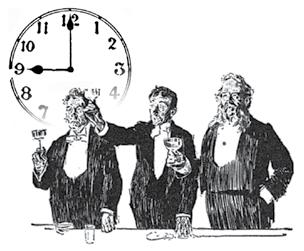
Undergoing an iterative lodge identity process will allow any lodge to develop its initial character more consciously and deliberately. A similar process could apply to a lodge that is working to improve its internal focus and how it presents itself to outsiders. By becoming more aware and strategic about how our lodges communicate their nature and their missions, significant benefit can be generated for the Fraternity in general as well as for its individual
ESOTERIC CONFERENCE
On November 23rd, the Masonic Education and Service Committee will be hosting a first-of-itskind event for our Grand Lodge – the Conference on the Hidden Influences of Craft Masonry, or “CHICM” (pronounced like Chicken, with an M). The Committee has already lined up more than a half dozen of the world’s foremost experts on such topics as Rosicrucianism, Martinism, Order of the Golden Dawn – and the Illuminati! For now, keep an eye on the Weekly Digest where we will be announcing each of our incredible Speakers, as we inch ever closer to November 23rd. The Hidden Influences Conference will be held at the D.C. Scottish Rite and will be a jam-packed day full of mind-blowing Esoterika –you won’t want to miss this event, Brethren!
Stay tuned for details coming soon.

VOL. 40, NO. 1, 2023 41
UNIVERSAL BROTHERHOOD CELEBRATION
Mark your calendars for this year’s Universal Brotherhood Celebration on June 14-16. Each year, we celebrate our beloved craft and highlight the universal brotherhood of our unique jurisdiction.
This year will be a very special event! The Grand Lodge of Washington, D.C., F.A.A.M., the Most Worshipful Prince Hall Grand Lodge of the District of Columbia (PHA), the D.C. Scottish Rite, and the Orient of the District of Columbia of the United Supreme Council 33° A.A.S.R. Southern Jurisdiction (PHA) have partnered to celebrate the 60th Anniversary of the 1964 Civil Rights Act.
We have been working in the quarries of Masonry planning this event since 2023, strengthening our Grand Lodges, and working shoulder to shoulder to make this Universal Brotherhood Celebration an event not to miss.
Friday, June 14th (Afternoon): Gathering at the Lincoln memorial for a prayer service, then proceeding
to the Martin Luther King Memorial for a wreath laying ceremony. OPEN TO MASONS AND FAMILIES.
Friday, June 14th (Evening):
Universal Banquet Dinner w/ award presentation. Cocktail hour before the event and dancing afterwards. Location: J.W. Marriott Hotel. OPEN TO MASONS AND FAMILIES. Tickets are $100.00 per person.
Saturday, June 15th: Universal Lodge with Educational Presentation. D.C. Grand Lodge will be opening a Universal Lodge at the Prince Hall Masonic Temple. The Prince Hall Grand Lodge will be exemplifying the EA Degree. Followed by a universal feast, international dining experience lunch. This is a MASON ONLY EVENT. Seats are limited. Feast tickets are $25. Limited parking available at Howard University with shuttle service to 1000 U Street NW (first come, first served, see registration).

THE VOICE OF FREEMASONRY 42
FOURTH OF JULY PARADE SIGN UP


As we commemorate the historic significance of Independence Day, the Fourth of July Celebration and Activities Committee invites you to join us to honor our country. Since its inception in 1776, Independence Day has served as a beacon of freedom, marking the birth of the United States of America and the values of liberty, equality, and democracy.
With applications accepted for all four parades in the city—National, Palisade, Capitol Hill, and Takoma Park—our dedicated Lodges and captains are poised to lead the charge,

showcasing our love for our nation and reinforcing the values we hold dear as Freemasons.
We hope that you will all join us to demonstrate our patriotism and appreciation for our beloved country on its birthday! We invite all Lodges to join us to celebrate.
The sign-up link is now available, and each participating Brother will receive a FREE high-quality polo shirt and a ball cap. Let's make this Fourth of July one to remember!
VOL. 40, NO. 1, 2023 43
THE VOICE OF FREEMASONRY
Grand Lodge, F.A.A.M. of D.C.
5428 MacArthur Blvd., NW
Washington, D.C. 20016-2524
GRAND LODGE OF FREE AND ACCEPTED MASONS OF THE DISTRICT OF COLUMBIA
Jacob M. Bressman, Grand Master RWB Adam J. Goldman, Grand Secretary
